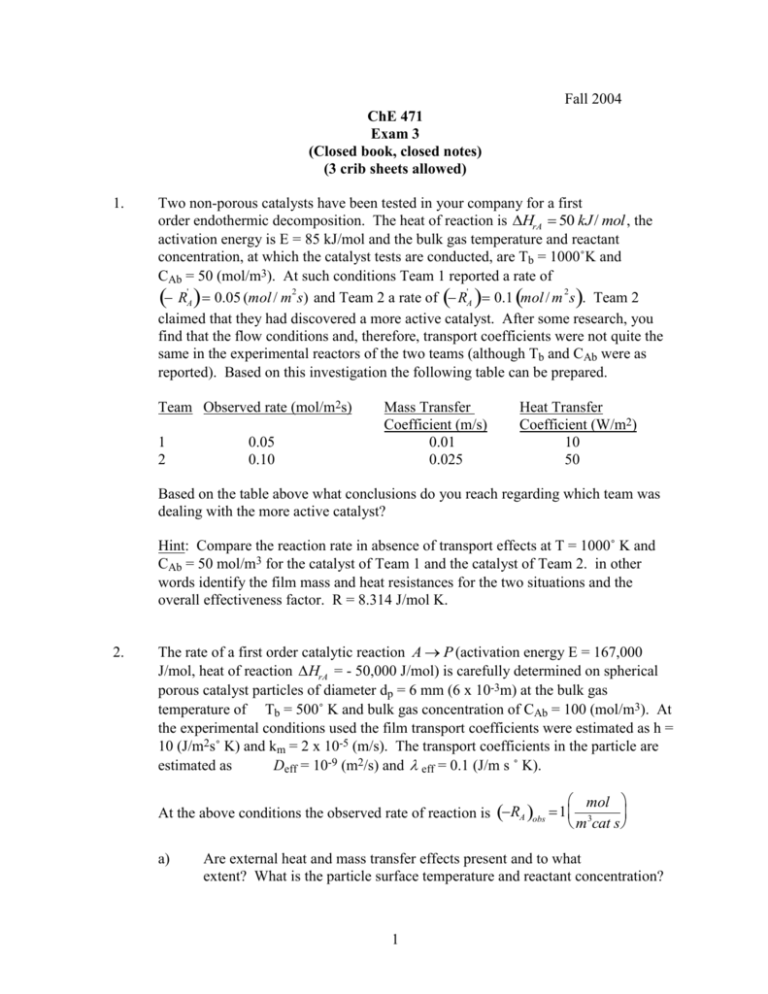ChE 471 Exam#3_2004
advertisement

Fall 2004 ChE 471 Exam 3 (Closed book, closed notes) (3 crib sheets allowed) 1. Two non-porous catalysts have been tested in your company for a first order endothermic decomposition. The heat of reaction is HrA 50 kJ / mol , the activation energy is E = 85 kJ/mol and the bulk gas temperature and reactant concentration, at which the catalyst tests are conducted, are Tb = 1000˚K and CAb = 50 (mol/m3). At such conditions Team 1 reported a rate of R'A 0.05 (mol / m2s) and Team 2 a rate of R'A 0.1 mol / m 2s. Team 2 claimed that they had discovered a more active catalyst. After some research, you find that the flow conditions and, therefore, transport coefficients were not quite the same in the experimental reactors of the two teams (although Tb and CAb were as reported). Based on this investigation the following table can be prepared. Team Observed rate (mol/m2s) 1 2 0.05 0.10 Mass Transfer Coefficient (m/s) 0.01 0.025 Heat Transfer Coefficient (W/m2) 10 50 Based on the table above what conclusions do you reach regarding which team was dealing with the more active catalyst? Hint: Compare the reaction rate in absence of transport effects at T = 1000˚ K and CAb = 50 mol/m3 for the catalyst of Team 1 and the catalyst of Team 2. in other words identify the film mass and heat resistances for the two situations and the overall effectiveness factor. R = 8.314 J/mol K. 2. The rate of a first order catalytic reaction A P (activation energy E = 167,000 J/mol, heat of reaction HrA = - 50,000 J/mol) is carefully determined on spherical porous catalyst particles of diameter dp = 6 mm (6 x 10-3m) at the bulk gas temperature of Tb = 500˚ K and bulk gas concentration of CAb = 100 (mol/m3). At the experimental conditions used the film transport coefficients were estimated as h = 10 (J/m2s˚ K) and km = 2 x 10-5 (m/s). The transport coefficients in the particle are estimated as Deff = 10-9 (m2/s) and eff = 0.1 (J/m s ˚ K). mol At the above conditions the observed rate of reaction is RA obs 1 3 m cat s a) Are external heat and mass transfer effects present and to what extent? What is the particle surface temperature and reactant concentration? 1 b) How pronounced is the internal diffusional resistance? Is the particle internally isothermal? c) What is the effectiveness factor d) (observed rate) (rate at conditions of outside catalyst surface) What is the overall effectiveness factor o (observed rate) (rate at bulk conditions) What is the rate at 500˚ K, CAb = 100 (mol/m3) in absence of all transport effects? Note: The universal gas constant is R = 8.314 (J/mol ˚ K). 3 An exothermic catalytic reaction, A = R with Hr A = - 100 kcal/mol, takes place in two tubular packed bed reactors in series, each of which operates adiabatically. The operational diagram is shown on the enclosed xA vs T sketch. From this information construct the flow sheet for this system. a) b) Show all the streams and their flow rates (molar flow rates), temperatures and conversions. Where pertinent, give the recycle ratios. Show the location of all heat exchangers and indicate whether they heat or cool. Calculate their heat duty (i.e. the heat to be added or removed). The inlet molar flow rate at point h is 100 mol/min. The specific heat and density of inerts and reaction mixture is the same and can be obtained from the adiabatic line (remember its slope?). The feed is at 350 K and the inerts are available at 310 K. Conversion and temperature at various points of the enclosed xA vs T sketch are: h(0; 350K) f(0.4; 350k) a(0.2; 350K) e(0.2; 370K) b(0.4; 390K) c(0.6; 330K) d(0.8; 350K) g(0.8; 310K) 2 xA g 0.8 d 0.6 c Tinert 0.4 f a 0.2 0 b j e h 300 320 340 360 380 400 T(K) Sketch of the xa vs T diagram for problem 3. 4. We conduct a first order decomposition A R S in an imperfectly mixed reactor with the E-curve shown below. E(mi n-1) 1 0.5 1 2 t(min) The rate of reaction is given by –RA = k CA (mol/L min) with k = 2 min-1. a) b) c) What is the mean residence time in this reactor? What conversion will be achieved in this reactor? Is this conversion prediction exact? Compare the above conversion to the one that you could obtain in a PFR and CSTR of the same mean residence time as the above reactor. 3







